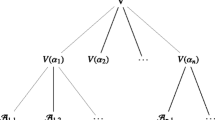Abstract
We put forward the hypothesis that there exist three basic attitudes towards inconsistencies within world views: (1) The inconsistency is tolerated temporarily and is viewed as an expression of a temporary lack of knowledge due to an incomplete or wrong theory. The resolution of the inconsistency is believed to be inherent to the improvement of the theory. This improvement ultimately resolves the contradiction and therefore we call this attitude the ‘regularising’ attitude; (2) The inconsistency is tolerated and both contradicting elements in the theory are retained. This attitude integrates the inconsistency and leads to a paraconsistent calculus; therefore we will call it the paraconsistent attitude. (3) In the third attitude, both elements of inconsistency are considered to be false and the ‘real situation’ is considered something different that can not be described by the theory constructively. This indicates the incompleteness of the theory, and leads us to a paracomplete calculus; therefore we call it the paracomplete attitude. We illustrate these three attitudes by means of two ‘paradoxical’ situations in quantum mechanics, the wave-particle duality and the situation of non locality.
Similar content being viewed by others
REFERENCES
D. Aerts: 1983, A Possible Explanation for the Probabilities of Quantum Mechanics and a Macroscopic Situation that Violates Bell Inequalities, in: P. Mittelstaedt et al., eds., Recent Developments in Quantum Logic, in Grundlagen der Exacten Naturwissenschaften, vol. 6. Wissenschaftverlag, Bibliographisches Institut, Mannheim, p. 235.
D. Aerts: 1986, A Possible Explanation for the Probabilities of Quantum Mechanics. J. Math. Phys. 27: 202.
D. Aerts: 1990, An Attempt to Imagine Parts of the Reality of the Micro-world. Proceedings of the Conference: Problems in Quantum Physics; Gdansk '89. World Scientific Publishing Company, Singapore, p. 3.
D. Aerts: 1992, The Construction of Reality and its Influence on the Understanding of Quantum Structures. Int. J. Theor. Phys. 31: 1815.
D. Aerts: 1995, Quantum Structures: An Attempt to Explain the Origin of their Appearance in Nature. Int. J. Theor. Phys. 34: 1165.
D. Aerts: 1999, The Stuff the World if Made Off: Physics and Reality, in: D. Aerts, J. Broekaert and E. Mathijs, eds., Science, Nature and Human Action, the White Book of 'Einstein Meets Magritte'. Kluwer Academic, Dordrecht, New York.
D. Aerts, L. Apostel, B. De Moor, S. Hellemans, E. Maex, H. Van Belle and J. Van der Veken: 1994a, World Views, From Fragmentation towards Integration. VUB-PRESS, Brussels Free University.
D. Aerts, L. Apostel, B. De Moor, S. Hellemans, E. Maex, H. Van Belle and J. Van der Veken: 1994b, Cirkelen om de Wereld, Concrete invulling van het wereldbeeldenproject. Pelckmans, Kappellen.
D. Aerts, B. Coecke and S. Smets: 1999, On the Origin of Probabilities in Quantum Mechanics: Creative and Contextual Aspects, in: G. Cornelis, S. Smets and J.P. Van Bendegem, eds., Metadebates: the Blue Book of 'Einstein Meets Magritte'. Kluwer Academic Publishers, Dordrecht, New York.
D. Aerts, H. Van Belle and J. Van der Veken (eds.): 1998, World Views and the Problem of Synthesis, the Yellow Book of 'Einstein Meets Magritte', Kluwer Academic, Dordrecht, New York.
L. Apostel and J. Van der Veken: 1991, Wereldbeelden, van fragmentering naar integratie. Pelckmans, Kappellen.
L. de Broglie: 1926, Sur la possibilité de relier les phénomè nes d'interference et de diffracton! a la théorie des quanta de lumiè re. Comptes Rendus 183: 447.
D. Bohm and J.P. Vigier: 1954, Model of the Causal Interpretation of Quantum Theory in Terms of a Fluid with Irregular Fluctuations. Physical Review 96: 208.
C. Cohen-Tannoudji, B. Diu and F. Laloë : 1973,Mécanique Quantique.Hermann, Paris.
R.P. Feynman: 1985, QED: The Strange Theory of Light and Matter. Princeton University Press, Princeton.
A. Galindo and P. Pascual: 1990, Quantum Mechanics I. Springer-Verlag, Berlin.
H. Rauch et al.: 1974, Test of a Single Crystal Neutron Interferometer. Phys. Lett. 47A: 369.
H. Rauch et al.: 1975, Verification of Coherent Spinor Rotations of Fermions. Phys. Lett. 54A: 425.
H. Rauch: 1988, Neutron Interferometric Tests of Quantum Mechanics. Helv. Phys. Acta 61: 589.
Author information
Authors and Affiliations
Rights and permissions
About this article
Cite this article
Aerts, D., Broekaert, J. & Smets, S. Inconsistencies in Constituent Theories of World Views: Quantum Mechanical Examples. Foundations of Science 3, 313–340 (1998). https://doi.org/10.1023/A:1009686326442
Issue Date:
DOI: https://doi.org/10.1023/A:1009686326442




